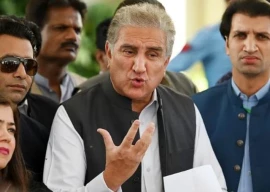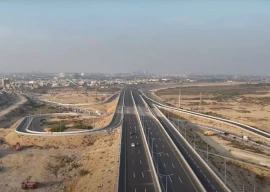
“How long will we have to live in camps like this? Our children can’t go to school, our businesses have closed and our lands are suffering,” Zafar says in frustration, adding that the government has yet to arrange alternate housing and compensation for him and his fellow villagers.
People who have been displaced by the swelling Attabad lake faced a second crisis when massive flooding hit the area in August. Anger and resentment are rife in relief camps where residents feel that their needs have been sidelined in the face of the floods that have crippled one-fifth of the country.
At least 19 people died in the massive landslide that struck Attabad early this year. The landslide blocked the Hunza River’s path and created a lake which, over the next few months, expanded up to 23 kilometres upstream. At least five villages — Ainabad, Shishkat, Gulmit, Hussaini and Gulkin — were swallowed up by the lake as it swelled.
After the landslide, the government, along with aid agencies like Focus Humanitarian Assistance and the Pakistan Red Crescent Society, immediately shifted over 2,000 residents of Attabad and other villages to camps in Hunza. Then, In June, when the lake threatened to reach full capacity and burst its banks, the government evacuated over 20,000 people from 36 villages downstream and shifted them to camps in Gilgit. The landslide also blocked the Karakoram Highway, a vital trade link to China, cutting off 26,000 people in the Upper Hunza Valley.
Asif Khan, an NGO worker in Gilgit, is frank in his estimation that the unprecedented floods could further delay the rehabilitation of the displaced people. “The devastation caused by the floods is much greater than the havoc caused by the lake — but still, the government should not underestimate the concerns of the Attabad lake IDPs,” he says.
Farman Karim, another resident of Attabad who, along with his family, lives in Altit camp in Hunza says the recent rains and floods further worsened life in the camp. “Water was everywhere, our children and women couldn’t go out to play or work. We remained confined to our camps for over a week,” he says, adding that a massive blackout triggered by the breakdown of hydel power projects compounded the miseries of camp residents. “Camp life turned into a nightmare,” he recalls. Electricity in Gilgit-Baltistan was cut off for over a week in August after floods swept away three major hydel power projects — Naltar, Guro and Kargah.
Karim came down hard on local politicians for being ‘ineffective’ during the nine-months between the floods and the landslide. “We recently demanded that senior minister Mohammad Jaffer resign because he failed to honour a commitment that he made to us in July,” Karim says, adding that residents of Attabad still stand by their demand.
In early July, hundreds of affected people had called off their protests in Hunza after Mohammad Jaffer assured them that he would use his influence to increase their compensation. The government had offered Rs500,000 to each family that lost land to the overflowing lake. The victims had rejected the compensation, saying the amount was negligible.
For their part, government officials in Hunza said that they are fully alive to the needs of the displaced people. “We have procured over 150 canals of land for the IDPs of Attabad and they will soon be rehabilitated,” says Zafar Taj, the deputy commissioner of Hunza-Nagar. He says that most of the people who had been evacuated from villages downstream as a precautionary measure in June had been repatriated recently. “The evacuation was a precautionary measure to ensure the safety of the public, but the situation is now satisfactory,” Taj says.
Taj agrees that flooding in the region had somewhat overshadowed the Attabad lake issue. “It was natural. If a bigger calamity emerges, our focus is shifted there to overcome the crisis.” He says that the government had offered each family Rs600,000 as compensation initially but later the Gilgit-Baltistan government increased the amount to Rs800,000.
The floods have definitely taken their toll on an already ravaged region, as district government official Iqbal says that around 4,000 people are currently homeless and live in camps, including those displaced by the Attabad lake.
According to official statistics, the floods damaged over 370 villages and 947 roads in Gilgit-Baltistan. Approximately 183 people were killed and hundreds injured in landslides during this time. Over 2,820 households were affected by the landslides that also washed away 5,000 heads of cattle. The floods also swept away 182 bridges in Gilgit-Baltistan, severing ties between villages for over one month and sparking a food crisis. In the agriculture sector, about 70,000 kilometres of land and 504 channels were affected or damaged.
After the floods, Gilgit-Baltistan’s Chief Minister Mehdi Shah had told the media that the total loss suffered by the region amounted to around Rs12 billion. However, the announcement had little or no effect on the jaded residents of Attabad and other villages that were submerged by the expanding lake months ago, because they had already been living as refugees, in camps or in their relative’s houses.
In fact, other victims of landslides in the region fear they will face the same fate as the residents of Attabad, because rock slides have begun blocking streams and rivers across the region, intensifying flooding. Mustafa, a resident of Chilas, says that Gaise village was completely submerged after a landslide following the floods had blocked a stream. “Out of 300 houses, no house in the lower Gaise village remains intact,” he laments. “We can only pray that we are spared from similar disasters in the future.”
Published in The Express Tribune, September 26th, 2010.












1736332856-0/Untitled-design-(20)1736332856-0-270x192.webp)


1736334465-0/sidra--(45)1736334465-0-270x192.webp)







COMMENTS
Comments are moderated and generally will be posted if they are on-topic and not abusive.
For more information, please see our Comments FAQ